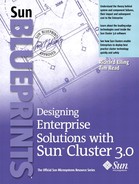Network Infrastructure
Network infrastructure (switches, hubs, routers, and bridges) is considered external to the system and is commonly overlooked as being a key component of system availability. The network infrastructure enables communication between peer and client systems at the local area network (LAN) and wide area network (WAN) levels. Therefore, network infrastructure scalability and availability directly affect system availability, even in a clustered environment.
A best practice is to use the network adapter failover (NAFO) software that the Sun Cluster 3.0 infrastructure provides to improve availability of the public network controllers. This improvement is accomplished by switching all network I/O to an alternate controller if the system detects a failure. Most network product vendors are becoming aware of the high availability needs of network infrastructure and are providing switch and router redundancy schemes to improve availability and scalability.
Client connections can improve availability through an alternate WAN link, which uses independent telephone switching stations to avoid SPOFs.
Customers with higher availability requirements should subscribe to the Internet through two different service providers, or at least use separate access points with the same provider to remove another SPOF.
In some cases, the primary network can be a leased line with the backup networks using virtual private network (VPN) connections over the Internet. This enables relatively inexpensive alternate network paths, since the VPN connections can coexist with other network services. If this option is chosen, ensure that the Internet connections access points are, in fact, different from the leased-line connections. Because the quality of service of a VPN is not likely to be guaranteed, the VPN option is not a direct replacement for leased lines in all cases.
